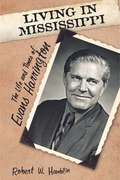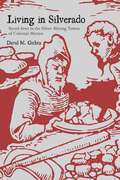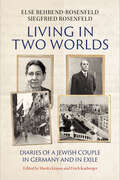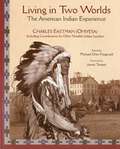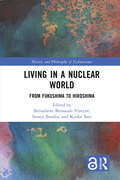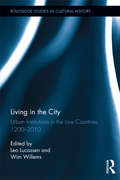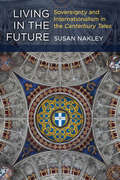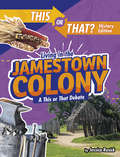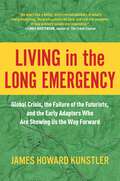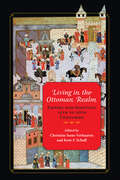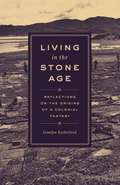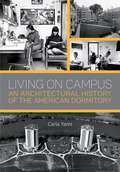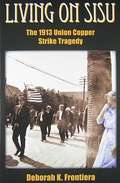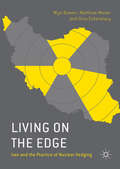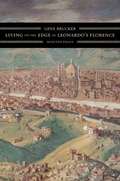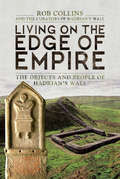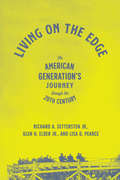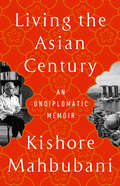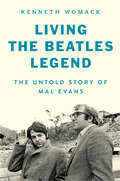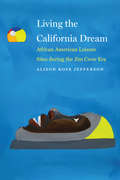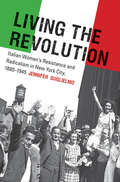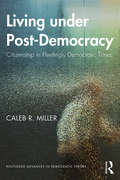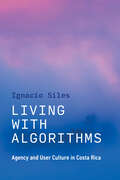- Table View
- List View
Living in Mississippi: The Life and Times of Evans Harrington
by Robert W. HamblinRobert W. Hamblin elevates Evans Harrington (1925-1997), as well as his remarkable achievements and writings, introducing his legacy to a new generation. Harrington continually found himself in conflict with the conservative, and often reactionary, institutions of his society--be they educational, political, or religious. Yet unlike many Mississippi liberals and moderates of his day--white as well as black--Harrington did not leave the state for a freer environment or better opportunities elsewhere. Except for his military service, he stayed in Mississippi his entire life, and his presence made a difference.In 1962, Harrington openly supported the enrollment of James Meredith, the first African American student to attend Ole Miss. In 1965, he invited African American students from Tougaloo College to attend the Southern Literary Festival hosted by Ole Miss--the first meeting of that organization to be integrated. In 1972, as faculty sponsor of Images, the Ole Miss literary journal, he joined his student writers in a successful suit against the university's attempt to suppress an issue of the magazine that contained controversial content. In 1996, Harrington united with other ACLU members to support the cause of Lisa Herdahl, who had brought suit against the North Pontotoc, Mississippi, School Board for allowing sectarian prayers and devotionals in public school classrooms. Hamblin presents these and other examples, showing Harrington both as an exception to and as a representative figure of his time and place.This biography also explores Harrington and his writings, which include "Living in Mississippi," a personal essay about being a white liberal in segregated Mississippi; several short stories; a novel, The Prisoners; and three popular novels issued under the pseudonym Gilbert Terrell: Willa, Missy, and Lily, as well as a number of unpublished manuscripts. Harrington also coedited, with Ann J. Abadie, four volumes of papers presented at the annual Faulkner and Yoknapatawpha Conference, which he cofounded.
Living in Silverado: Secret Jews in the Silver Mining Towns of Colonial Mexico
by David M. GitlitzIn this thoroughly researched work, David M. Gitlitz traces the lives and fortunes of three clusters of sixteenth-century crypto-Jews in Mexico&’s silver mining towns. Previous studies of sixteenth-century Mexican crypto-Jews focus on the merchant community centered in Mexico City, but here Gitlitz looks beyond Mexico&’s major population center to explore how clandestine religious communities were established in the reales, the hinterland mining camps, and how they differed from those of the capital in their struggles to retain their Jewish identity in a world dominated economically by silver and religiously by the Catholic Church.In Living in Silverado Gitlitz paints an unusually vivid portrait of the lives of Mexico&’s early settlers. Unlike traditional scholarship that has focused mainly on macro issues of the silver boom, Gitlitz closely analyzes the complex workings of the haciendas that mined and refined silver, and in doing so he provides a wonderfully detailed sense of the daily experiences of Mexico&’s early secret Jews.
Living in Two Worlds: Diaries of a Jewish Couple in Germany and in Exile
by Else Behrend-Rosenfeld Siegfried RosenfeldThis unique collection of diaries and letters offers a vivid personal account of the experiences of a Jewish couple living parallel lives during the Second World War. While their children left for England just before war broke out, and Siegfried soon followed, Else Behrend was unable to obtain her visa in time, and remained in Germany. This volume includes Else's account of her years of persecution under the Nazi dictatorship, and of her life underground in Berlin, before her eventual daring escape to Switzerland on foot in 1944. Her dramatic story is presented alongside Siegfried's account of his very different experience, living penniless and in isolation in England, as well as some of her letters to her close friend and confidante, Eva. Complemented by QR codes that allow readers to listen to Else's own voice from her 1963 BBC interviews. Published in English for the first time, Living in Two Worlds offers an unforgettable and moving insight into the impact of the Second World War on everyday life.
Living in Two Worlds: The American Indian Experience
by Charles EastmanThis beautifully illustrated book presents a vivid account of the American Indian experience as seen through the eyes of Charles Eastman (Ohiyesa), the first and greatest of the Native American authors. The importance of Eastman's life story was reiterated for a new generation when the 2007 HBO film entitled Bury My Heart at Wounded Knee used Eastman, played by Adam Beach, as its leading hero.
Living in a Nuclear World: From Fukushima to Hiroshima (History and Philosophy of Technoscience)
by Bernadette Bensaude-VincentThe Fukushima disaster invites us to look back and probe how nuclear technology has shaped the world we live in, and how we have come to live with it. Since the first nuclear detonation (Trinity test) and the bombings of Hiroshima and Nagasaki, all in 1945, nuclear technology has profoundly affected world history and geopolitics, as well as our daily life and natural world. It has always been an instrument for national security, a marker of national sovereignty, a site of technological innovation and a promise of energy abundance. It has also introduced permanent pollution and the age of the Anthropocene. This volume presents a new perspective on nuclear history and politics by focusing on four interconnected themes–violence and survival; control and containment; normalizing through denial and presumptions; memories and futures–and exploring their relationships and consequences. It proposes an original reflection on nuclear technology from a long-term, comparative and transnational perspective. It brings together contributions from researchers from different disciplines (anthropology, history, STS) and countries (US, France, Japan) on a variety of local, national and transnational subjects. Finally, this book offers an important and valuable insight into other global and Anthropocene challenges such as climate change.
Living in the City: Urban Institutions in the Low Countries, 1200–2010 (Routledge Studies in Cultural History)
by Leo Lucassen Wim WillemsThe city is a place to find shelter, a market place, and an elevator for social mobility and success. But the city is also a place that frightens people and that can marginalize newcomers. Living in the City tries to understand what pulls people to the city since the High Middle Ages, focusing on one of the earliest urbanized regions in the world, the Low Countries. The book is a quest for new insights that leads the reader from Medieval Ghent and Bruges, through the Dutch Golden Age and the mass urbanization in the age of Industrialization to the present Eurodelta. A region that emerged in the last century with Antwerp, Rotterdam and Amsterdam as nodal points in a global urban network. To understand the motivations of so many to settle in cities this book focuses on a wide variety of urban institutions. What was the role of churches, guilds and businesses, but also theaters, architecture, parks and pavements? What were the cultural, economic, social, political and spatial dynamics that transformed cities into centers of creativity and innovation? How did the attractiveness of cities change over time, when cities lost their autonomy and became part of the nation state and global forces? In this book a team of internationally reknown scholars (in the field of history, art, literature, economy and the social sciences) look for continuity and change in the last eight centuries of urban developments in one of the most remarkable urban regions of the world.
Living in the Future: Sovereignty and Internationalism in the Canterbury Tales
by Susan NakleyNationalism, like medieval romance literature, recasts history as a mythologized and seamless image of reality. Living in the Future analyzes how the anachronistic nationalist fantasies in Geoffrey Chaucer’s Canterbury Tales create a false sense of England’s historical continuity that in turn legitimized contemporary political ambitions. This book spells out the legacy of the Tales that still resonates throughout English literature, exploring the idea of England in the medieval literary imagination as well as critiquing more recent centuries’ conceptions of Chaucer’s nationalism. Chaucer uses two extant national ideals, sovereignty and domesticity, to introduce the concept of an English nation into the contemporary popular imagination and reinvent an idealized England as a hallowed homeland. For nationalist thinkers, sovereignty governs communities with linguistic, historical, cultural, and religious affinities. Chaucerian sovereignty appears primarily in romantic and household contexts that function as microcosms of the nation, reflecting a pseudo-familial love between sovereign and subjects and relying on a sense of shared ownership and judgment. This notion also has deep affinities with popular and political theories flourishing throughout Europe. Chaucer’s internationalism, matched with his artistic use of the vernacular and skillful distortions of both time and space, frames a discrete sovereign English nation within its diverse interconnected world. As it opens up significant new points of resonance between postcolonial theories and medieval ideas of nationhood, Living in the Future marks an important contribution to medieval literary studies. It will be essential for scholars of Middle English literature, literary history, literary political and postcolonial theory, and literary transnationalism.
Living in the Jamestown Colony: A This or That Debate (This or That?: History Edition)
by Jessica RusickIn May 1607, English settlers stepped off their ship in North America. They were about to start the first permanent English settlement in North America. They endured many hardships and made many tough choices in the new land. Now the choices are yours. Would you rather suffer from intestinal problems after becoming infected with dysentery or have bleeding gums after getting scurvy? Would you want to work as a blacksmith or tend the tobacco fields? It's your turn to pick this or that!
Living in the Long Emergency: Global Crisis, the Failure of the Futurists, and the Early Adapters Who Are Showing Us the Way Forward
by James Howard KunstlerForget the speculation of pundits and media personalities. For anyone asking "Now what?" the answer is out there. You just have to know where to look. In his 2005 book, The Long Emergency, James Howard Kunstler described the global predicaments that would pitch the USA into political and economic turmoil in the 21st century—the end of affordable oil, climate irregularities, and flagging economic growth, to name a few. Now, he returns with a book that takes an up-close-and-personal approach to how real people are living now—surviving The Long Emergency as it happens. Through his popular blog, Clusterf*ck Nation, Kunstler has had the opportunity to connect with people from across the country. They've shared their stories with him—sometimes over years of correspondence—and in Living in the Long Emergency: Global Crisis, the Failure of the Futurists, and the Early Adapters Who Are Showing Us the Way Forward, he shares them with us, offering an eye-opening and unprecedented look at what's really going on "out there" in the US—and beyond. Kunstler also delves deep into his past predictions, comparing and contrastingt hem with the way things have unfolded with unflinching honesty. Further, he turns an eye to what's ahead, laying out the strategies that will help all of us as we navigate this new world. With personal accounts from a Vermont baker, homesteaders, a building contractor in the Baltimore ghetto, a white nationalist, and many more, Living in the Long Emergency is a unique and timely exploration of how the lives of everyday Americans are being transformed, for better and for worse, and what these stories tell us both about the future and about human perseverance.
Living in the Ottoman Realm: Empire and Identity, 13th to 20th Centuries
by Kent F. Schull Christine Isom-VerhaarenLiving in the Ottoman Realm brings the Ottoman Empire to life in all of its ethnic, religious, linguistic, and geographic diversity. The contributors explore the development and transformation of identity over the long span of the empire's existence. They offer engaging accounts of individuals, groups, and communities by drawing on a rich array of primary sources, some available in English translation for the first time. These materials are examined with new methodological approaches to gain a deeper understanding of what it meant to be Ottoman. Designed for use as a course text, each chapter includes study questions and suggestions for further reading.
Living in the Stone Age: Reflections on the Origins of a Colonial Fantasy
by Danilyn RutherfordIn 1961, John F. Kennedy referred to the Papuans as “living, as it were, in the Stone Age.” For the most part, politicians and scholars have since learned not to call people “primitive,” but when it comes to the Papuans, the Stone-Age stain persists and for decades has been used to justify denying their basic rights. Why has this fantasy held such a tight grip on the imagination of journalists, policy-makers, and the public at large? Living in the Stone Age answers this question by following the adventures of officials sent to the New Guinea highlands in the 1930s to establish a foothold for Dutch colonialism. These officials became deeply dependent on the good graces of their would-be Papuan subjects, who were their hosts, guides, and, in some cases, friends. Danilyn Rutherford shows how, to preserve their sense of racial superiority, these officials imagined that they were traveling in the Stone Age—a parallel reality where their own impotence was a reasonable response to otherworldly conditions rather than a sign of ignorance or weakness. Thus, Rutherford shows, was born a colonialist ideology. Living in the Stone Age is a call to write the history of colonialism differently, as a tale of weakness not strength. It will change the way readers think about cultural contact, colonial fantasies of domination, and the role of anthropology in the postcolonial world.
Living on Campus: An Architectural History of the American Dormitory
by Carla YanniAn exploration of the architecture of dormitories that exposes deeply held American beliefs about education, youth, and citizenshipEvery fall on move-in day, parents tearfully bid farewell to their beloved sons and daughters at college dormitories: it is an age-old ritual. The residence hall has come to mark the threshold between childhood and adulthood, housing young people during a transformational time in their lives. Whether a Gothic stone pile, a quaint Colonial box, or a concrete slab, the dormitory is decidedly unhomelike, yet it takes center stage in the dramatic arc of many American families. This richly illustrated book examines the architecture of dormitories in the United States from the eighteenth century to 1968, asking fundamental questions: Why have American educators believed for so long that housing students is essential to educating them? And how has architecture validated that idea? Living on Campus is the first architectural history of this critical building type. Grounded in extensive archival research, Carla Yanni&’s study highlights the opinions of architects, professors, and deans, and also includes the voices of students. For centuries, academic leaders in the United States asserted that on-campus living enhanced the moral character of youth; that somewhat dubious claim nonetheless influenced the design and planning of these ubiquitous yet often overlooked campus buildings. Through nuanced architectural analysis and detailed social history, Yanni offers unexpected glimpses into the past: double-loaded corridors (which made surveillance easy but echoed with noise), staircase plans (which prevented roughhousing but offered no communal space), lavish lounges in women&’s halls (intended to civilize male visitors), specially designed upholstered benches for courting couples, mixed-gender saunas for students in the radical 1960s, and lazy rivers for the twenty-first century&’s stressed-out undergraduates. Against the backdrop of sweeping societal changes, communal living endured because it bolstered networking, if not studying. Housing policies often enabled discrimination according to class, race, and gender, despite the fact that deans envisioned the residence hall as a democratic alternative to the elitist fraternity. Yanni focuses on the dormitory as a place of exclusion as much as a site of fellowship, and considers the uncertain future of residence halls in the age of distance learning.
Living on Sisu: The 1913 Union Copper Strike Tragedy
by Deborah K. FrontieraLiving On Sisu: The 1913 Union Copper Strike Tragedy
Living on the Edge
by Wyn Bowen Dina Esfandiary Matthew MoranIn this book, the authors explore the controversial Iranian nuclear programme through the conceptual lens of nuclear hedging. In 2002, revelations regarding undeclared nuclear facilities thrust Iran's nuclear activities under the spotlight and prompted concerns that Tehran was pursuing nuclear weapons. Iran has always denied nuclear weapons aspirations, yet it cannot be disputed that the Islamic Republic has gone well beyond what is required for a civil nuclear programme based on energy production and scientific research. What, then, is the nature and significance of Iran's nuclear behaviour? Does it form part of a coherent strategy? What can Iran's actions in the nuclear field tell us about Tehran's intentions? And what does the Iranian case teach us about proliferation behaviour more generally? This book addresses these questions by exploring the nature of nuclear hedging and how this approach might be identified, before applying this logic to the Iranian case. It provides fresh insights into the inherently opaque area of nuclear proliferation and a more nuanced interpretation of the Iranian nuclear challenge.
Living on the Edge in Leonardo's Florence: Selected Essays
by Gene A. BruckerThis book provides a splendid overview of Italian history from the Black Death to the rise of the Medici in 1434 and beyond into the early modern period. Gene Brucker explores those pivotal years in Florence and ranges over northern Italy, with forays into the histories of Genoa, Milan, and Venice.
Living on the Edge of Empire: The Objects and People of Hadrian's Wall
by Rob Collins“Beautiful . . . an essential book for anyone with an interest in the material culture of the Roman frontier in its wider context.” —Current ArchaeologyDr. Rob Collins and the curators of the remarkable collections from Hadrian’s Wall present a striking new contribution to understanding the archaeology of a Roman frontier.This highly illustrated volume showcases the artifacts recovered from archaeological investigations along Hadrian’s Wall in order to examine the daily lives of those living along the Northern Frontier of the Roman Empire. Presented by theme, no other book offers such a diverse and thorough range of the rich material culture of the Wall. The accompanying text provides an ethnographic perspective, guiding us through the everyday lives of the people of frontier communities, from the Commanding Officer to the local farmer. This holistic view allows us an insight into the homes and communities, how people dressed, what they ate and drank, their religions and beliefs, domestic and military forms of security, and how they conducted their business and pleasure.“With so many of the objects described and set in context in this fine book, it gives no more than a brief bright flash of lives once led, and yet provides such a spark for the imagination.” —Hexham Local History Society Newsletter
Living on the Edge of Empire: The Objects and People of Hadrian's Wall
by Rob CollinsDr Rob Collins and the curators of the remarkable collections from Hadrian's Wall present a striking new contribution to understanding the archaeology of a Roman frontier.Dr Rob Collins and the curators of the remarkable collections from Hadrian's Wall present a striking new contribution to understanding the archaeology of a Roman frontier. This highly illustrated volume showcases the artifacts recovered from archaeological investigations along Hadrian's Wall in order to examine the daily lives of those living along the Northern Frontier of the Roman Empire. Presented by theme, no other book offers such a diverse and thorough range of the rich material culture of the Wall. The accompanying text provides an ethnographic perspective, guiding us through the everyday lives of the people of frontier communities, from the Commanding Officer to the local farmer. This holistic view allows us an insight into the homes and communities, how people dressed, what they ate and drank, their religions and beliefs, domestic and military forms of security, and how they conducted their business and pleasure.
Living on the Edge: An American Generation’s Journey through the 20th Century
by Richard A. Settersten Jr. Glen H. Elder Lisa D. PearceHistory carves its imprint on human lives for generations after. When we think of the radical changes that transformed America during the twentieth century, our minds most often snap to the fifties and sixties: the Civil Rights Movement, changing gender roles, and new economic opportunities all point to a decisive turning point. But these were not the only changes that shaped our world, and in Living on the Edge, we learn that rapid social change and uncertainty also defined the lives of Americans born at the turn of the twentieth century. The changes they cultivated and witnessed affect our world as we understand it today. Drawing from the iconic longitudinal Berkeley Guidance Study, Living on the Edge reveals the hopes, struggles, and daily lives of the 1900 generation. Most surprising is how relevant and relatable the lives and experiences of this generation are today, despite the gap of a century. From the reorganization of marriage and family roles and relationships to strategies for adapting to a dramatically changing economy, the challenges faced by this earlier generation echo our own time. Living on the Edge offers an intimate glimpse into not just the history of our country, but the feelings, dreams, and fears of a generation remarkably kindred to the present day.
Living the Asian Century: An Undiplomatic Memoir
by Kishore MahbubaniIn this stirring memoir, a preeminent politician and diplomat traces the transformation of the Republic of Singapore from a poor colony into an Asian powerhouse. In Living the Asian Century, Kishore Mahbubani vividly chronicles his own life going from a poor childhood in a multiethnic neighborhood to an illustrious diplomatic career that led him far from Singapore to the United States. Along the way Mahbubani has become one of Asia&’s most widely known commentators and spokespeople, with a unique perspective that straddles India, China, and the West.
Living the Beatles Legend: The Untold Story of Mal Evans
by Kenneth WomackThe first full-length biography of Mal Evans, the Beatles’ beloved friend, confidant, and roadie. Malcolm Evans, the Beatles’ long-time roadie, personal assistant, and devoted friend, was an invaluable member of the band’s inner circle. A towering figure in horn-rimmed glasses, Evans loomed large in the Beatles’ story, contributing at times as a performer and sometime lyricist, while struggling mightily to protect his beloved “boys.” He was there for the whole of the group’s remarkable, unparalleled story: from the Shea Stadium triumph through the creation of the timeless cover art for Sgt. Pepper’s Lonely Hearts Club Band and the famous Let It Be rooftop concert. Leaving a stable job as telecommunications engineer to serve as road manager for this fledgling band, Mal was the odd man out from the start—older, married with children, and without any music business experience. And yet he threw himself headlong into their world, traveling across the globe and making himself indispensable. In the years after the Beatles’ disbandment, Big Mal continued in their employ as each embarked upon solo careers. By 1974, he was determined to make his name as a songwriter and record producer, setting off for a new life in Los Angeles, where he penned his memoirs. But in January 1976, on the verge of sharing his book with the world, Evans’s story came to a tragic end during a domestic standoff with the LAPD.For Beatles devotes, Mal’s life and untimely death have always been shrouded in mystery. For decades, his diaries, manuscripts, and vast collection of memorabilia was missing, seemingly lost forever…until now. Working with full access to Mal’s unpublished archives and having conducted hundreds of new interviews, Beatles’ scholar and author Kenneth Womack affords readers with a full telling of Mal’s unknown story at the heart of the Beatles’ legend. Lavishly illustrated with unseen photos and ephemera from Mal’s archives, Living the Beatles’ Legend: The Untold Story of Mal Evans is the missing puzzle piece in the Fab Four’s incredible story.
Living the California Dream: African American Leisure Sites during the Jim Crow Era
by Alison Rose JeffersonAs Southern California was reimagining leisure and positioning it at the center of the American Dream, African American Californians were working to make that leisure an open, inclusive reality. By occupying recreational sites and public spaces, African Americans challenged racial hierarchies and marked a space of black identity on the regional landscape and social space. In Living the California Dream Alison Rose Jefferson examines how African Americans pioneered America&’s &“frontier of leisure&” by creating communities and business projects in conjunction with their growing population in Southern California during the nation&’s Jim Crow era. By presenting stories of Southern California African American oceanfront and inland leisure destinations that flourished from 1910 to the 1960s, Jefferson illustrates how these places helped create leisure production, purposes, and societal encounters. Black communal practices and economic development around leisure helped define the practice and meaning of leisure for the region and the nation, confronted the emergent power politics of recreational space, and set the stage for the sites as places for remembrance of invention and public contest. Living the California Dream presents the overlooked local stories that are foundational to the national narrative of mass movement to open recreational accommodations to all Americans and to the long freedom rights struggle.
Living the Revolution: Italian Women's Resistance and Radicalism in New York City, 1880-1945
by Jennifer GuglielmoItalians were the largest group of immigrants to the United States at the turn of the twentieth century, and hundreds of thousands led and participated in some of the period's most volatile labor strikes. Yet until now, Italian women's political activism and cultures of resistance have been largely invisible. In Living the Revolution, Jennifer Guglielmo brings to life the Italian working-class women who helped shape the vibrant, transnational, radical political culture that expanded into the emerging industrial union movement. Guglielmo imaginatively documents the activism of two generations of New York and New Jersey women who worked in the needle and textile trades. She explores the complex and distinctive ways immigrant women and their American-born daughters drew on Italian traditions of protest to form new urban female networks of everyday resistance and political activism. And she shows how their commitment to revolutionary and transnational social movements diminished as they became white working-class Americans. The rise of fascism, the Red Scare, and the deprivations of the Great Depression led many to embrace nationalism and racism, ironically to try to meet the same desires for economic justice and dignity that had inspired their enthusiasm for anarchism, socialism, and communism.
Living under Post-Democracy: Citizenship in Fleetingly Democratic Times (Routledge Advances in Democratic Theory)
by Caleb R. MillerWhen money equates to power and the system is rigged in favor of wealthy elites, why do we still pretend we are living in a democracy? In Living under Post-Democracy, Caleb R. Miller challenges us to admit what we already know: that most of us are effectively powerless over the political decisions that govern our lives. Instead, we should embrace a 'post-democratic' view of politics, one which recognizes the way in which our political institutions fail—both systematically and historically—to live up to our democratic ideals, while also acknowledging our tragic, yet enduring attachment to them both. Offering a new framework for conceptualizing contemporary citizenship, Miller explores how a post-democratic perspective can help us begin to reorient ourselves in our paradoxical, fractured political landscape. This model of citizenship opens the possibility for a distinctly post-democratic approach to both political participation and political philosophy, treating them not as ways of affecting politics, but as opportunities for therapeutically engaging with the ongoing challenges and inevitable frustrations of post-democratic life. This book is an excellent addition to courses on democratic theory, as well as introductory courses to political theory.
Living with Algorithms: Agency and User Culture in Costa Rica
by Ignacio SilesA nuanced account from a user perspective of what it&’s like to live in a datafied world.We live in a media-saturated society that increasingly transforms our experiences, relations, and identities into data others can analyze and monetize. Algorithms are key to this process, surveilling our most mundane practices, and to many, their control over our lives seems absolute. In Living with Algorithms, Ignacio Siles critically challenges this view by surveying user dynamics in the global south across three algorithmic platforms—Netflix, Spotify, and TikTok—and finds, surprisingly, a more balanced relationship. Drawing on a wealth of empirical evidence that privileges the user over the corporate, Siles examines the personal relationships that have formed between users and algorithms as Latin Americans have integrated these systems into the structures of everyday life, enacted them ritually, participated in public with and through them, and thwarted them. Sometimes users follow algorithms, Siles finds, and sometimes users resist them. At times, users do both. Agency lies in the navigation of the spaces in-between. By analyzing what we do with algorithms rather than what algorithms do to us, Living with Algorithms clarifies the debate over the future of datafication and whether we have a say in its development. Concentrating on an understudied region of the global south, the book provides a new perspective on the commonalities and differences among users within a global ecology of technologies.
Living with Animals
by Michael PomedliWithin nineteenth-century Ojibwe/Chippewa medicine societies, and in communities at large, animals are realities and symbols that demonstrate cultural principles of North American Ojibwe nations. Living with Animals presents over 100 images from oral and written sources - including birch bark scrolls, rock art, stories, games, and dreams - in which animals appear as kindred beings, spirit powers, healers, and protectors.Michael Pomedli shows that the principles at play in these sources are not merely evidence of cultural values, but also unique standards brought to treaty signings by Ojibwe leaders. In addition, these principles are norms against which North American treaty interpretations should be reframed. The author provides an important foundation for ongoing treaty negotiations, and for what contemporary Ojibwe cultural figures corroborate as ways of leading a good, integrated life.
